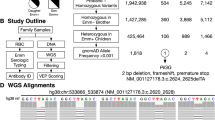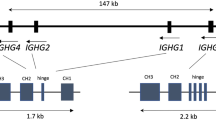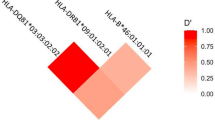Abstract
The Rhesus (RH) blood group locus is composed of two related structural genes, D and CcEe, that encode red cell membrane proteins carrying the D, Cc and Ee antigens. As demonstrated previously, the RhD–positive/RhD–negative polymorphism is associated with the presence or the absence of the D gene. Sequence analysis of transcripts and genomic DNA from individuals that belong to different Rh phenotypes were performed to determine the molecular basis of the C/c and E/e polymorphisms. The E and e alleles differ by a single nucleotide resulting in a Pro226Ala substitution, whereas the C and c alleles differ by six nucleotides producing four amino acid substitutions Cys16Trp, He60Leu, Ser68Asn and Ser103Pro. With the recent cloning of the RhD gene, these findings provide the molecular genetic basis that determine D, C, c, E and e specificities.
This is a preview of subscription content, access via your institution
Access options
Subscribe to this journal
Receive 12 print issues and online access
$209.00 per year
only $17.42 per issue
Buy this article
- Purchase on Springer Link
- Instant access to full article PDF
Prices may be subject to local taxes which are calculated during checkout
Similar content being viewed by others
References
Race, R.R. & Sanger, R. Blood Groups in Man, 6th edn (Blackwell, Oxford, 1975).
Petz, L.D. & Garratty, G. Acquired immune hemolytic anemias (Churchill Livingstone, New York, 1980).
Mollison, P.L., Engelfriet, C.P. & Contreras, M. Blood Transfusion in Clinical Medicine 9th edn (Blackwell, Oxford, 1992).
Sturgeon, P. Hematological observations on the anemia associated with blood type Rh-null. Blood 36, 310–320 (1970).
Nash, R. & Shojania, A.M. Hematological aspect of Rh deficiency syndrome: a case report and review of the literature. Am. J. Hematol. 24, 267–275 (1987).
Lauf, P.K. & Joiner, C.H. Increased potassium transport and ouabain binding in human Rh-null red blood cells. Blood 48, 457–468 (1976).
Ballas, S. et al. Red cell membranes and cation deficiency in Rh null syndrome. Blood 63, 1046–1055 (1984).
Kuypers, F. et al. Rh-null human erythrocytes have an abnormal membrane phospholipid organization. Biochem. J. 221, 931–934 (1984).
Issitt, P.D. The Rh blood group system, 1988: Eight new antigens in nine years and some observations on the biochemistry and genetics of the system. Transl Med. Rev. 3, 1–12 (1989).
Agre, P. & Cartron, J.P. Molecular biology of the Rh antigens. Blood 78, 551–563 (1991).
Chérif-Zahar, B. et al. Molecular cloning and protein structure of a human blood group Rh polypeptide. Proc. natn Acad. Sci. U.S.A. 87, 6243–6247 (1990).
Avent, N.D., Ridgwell, K., Tanner, M.J.A. & Anstee, D.J. cDNA cloning of a 30 kDa erythrocyte membrane protein associated with Rh (Rhesus)-blood-group-antigen expression. Biochem. J. 271, 821–825 (1990).
Le Van Kim, C. et al. Molecular cloning and primary structure of the human blood group RhD polypeptide. Proc. natn. Acad. Sci. U.S.A. 89, 10925–10929 (1992).
Colin, Y. et al. Genetic basis of the RhD-positive and RhD-negative blood group polymorphism as determined by Southern analysis. Blood 78, 2747–2752 (1991).
Le Van Kim, C. et al. Multiple Rh mRNAs isoforms are produced by alternative splicing and poly(A) site choice. Blood 80, 1074–1078 (1992).
Blanchard, D. et al. Two-dimensional iodopeptide mapping demonstrates erythrocyte Rh D, c, and E polypeptides are structurally homologous but nonidentical. Blood 72, 1424–1427 (1988).
Bloy, C. et al. Determination of the N-terminal sequence of human red cell Rh(D) polypeptide and demonstration that the Rh(D), (c) and (E) antigens are carried by distinct polypeptide chains. Blood 72, 661–666 (1988).
Saabori, A.M. et al. Polymorphism in the Mr 32,000 Rh protein purified from Rh(D)-positive and -negative erythrocytes. Proc. natn. Acad. Sci. U.S.A. 85, 4042–4045 (1988).
Avent, N.D. et al. Protein-sequence studies of Rh-related polypeptides suggest the presence of at least two groups of proteins which associated in the human red cell membrane. Biochem. J. 256, 1043–1046 (1988).
Hermand, P. et al. Immunochemical characterization of Rh proteins with antibodies raised against synthetic peptides. Blood 82, (1993).
Tippett, P. A speculative model for the Rh blood groups. Ann. Hum. Genet. 50, 241 (1986).
Yamamoto, F., Clausen, H., White, T., Marken, J. & Hakomori, S.I. Molecular genetic basis of the histo-blood group ABO system. Nature 345, 229–233 (1990).
Landsteiner, K. Zur Kenntnis des antifermentativen, lytischen und agglutinierenden Wirkungen des Blutserums und der Lymphe. Zbl. Bakt. 27, 357–363 (1900).
Landsteiner, K. & Wiener, A.S. An agglutinable factor in human blood recognized by immune sera for rhesus blood. Proc. Soc. Exp. Biol. Med. 43, 223 (1940).
Levine, P. & Stetson, R.E. An unusual case of intragroup agglutination. JAMA 113, 126–127 (1939).
Izraeli, S., Pfleiderer, C. & Lion, T. Detection of gene expression by PCR amplification of RNA derived from frozen heparinized whole blood. Nucl. Acid. Res. 19, 6051 (1991).
Goossens, M. & Kan, Y.Y. DNA analysis in the diagnosis of hemoglobin disorders. Meth. Enzymol. 76, 805–817 (1981).
Sanger, F., Nicklen, S. & Coulson, A.R. DNA sequencing with chain-terminating inhibitors. Proc. natn. Acad. Sci. U.S.A. 74, 5463–5467 (1977).
Author information
Authors and Affiliations
Rights and permissions
About this article
Cite this article
Mouro, I., Colin, Y., Chérif-Zahar, B. et al. Molecular genetic basis of the human Rhesus blood group system. Nat Genet 5, 62–65 (1993). https://doi.org/10.1038/ng0993-62
Received:
Accepted:
Issue Date:
DOI: https://doi.org/10.1038/ng0993-62
This article is cited by
-
Evolutionary genetics of the human Rh blood group system
Human Genetics (2012)
-
The molecular genetics of blood group polymorphism
Human Genetics (2009)
-
Tempo and mode of evolution of the Rh blood group genes before and after gene duplication
Immunogenetics (2007)



